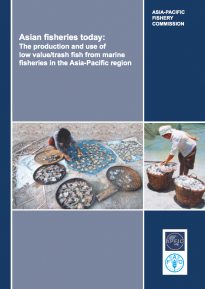Application of Appropriate Technology for Discards and Bycatch
Technology associated with discards, bycatch and reducing food loss and waste (FLW) includes selective fishing gear, bycatch utilization and data collection.
Gear Selectivity
Gear Selectivity
Fisheries management measures designed to reduce FLW include those related to selective fishing gear. Fishing gear mesh size restrictions can reduce the capture of small, undersized fish, but this can have limitations in multi-species fisheries. When organisms of different shapes and sizes occur on the same fishing ground, immature individuals of a co-occurring larger species might still be captured. When considering the introduction of mesh size regulations in a trawl fishery, it is also important to consider the survival rate of the organisms that escape through cod end meshes. If mortality is high, the anticipated benefit of larger meshes may not be achieved.
Selectivity can be improved through a variety of methods other than mesh size, including the use of different mesh shapes, size, and species sorting grids, and other designs and devices which can be fitted to existing gear to enable the unwanted portion of the catch to escape.
There are two basic types of selection: by species and by size within each species. The species selection process is largely determined by evolution, design and deployment of the particular gear. The size selection is determined mainly by the size and orientation of the meshes or other escape mechanism.
Bycatch Utilization
Bycatch Utilization
Value can be added to fish bycatch via two methods: mass transformation and sorting. Mass transformation of fish waste involves the conversion of all waste into a single product (e.g. fish meal, fish oil, fertiliser and hydrolysates).
Sorting involves the separation of different species or waste products (e.g. bones, guts, fins), which enables each component to be used individually for sale or the production of specialised products. Some examples of products produced from processed sorted bycatch include liver oil, gelatine, omega 3, protein sports food/drinks, calcium, cosmetics, biotechnical applications and pharmaceuticals.
Many countries report that some low value/trash fish are used as direct feeds for livestock and aquaculture. There has been considerable innovation in recent years in an attempt to utilise previously unwanted bycatch, especially from shrimp trawl fisheries and from finfish trawlers. Many of these activities have been the result of bycatch utilisation programmes supported by governments, research, or development agencies, while some have been driven primarily by the market. Uptake of value-added products from bycatch has been successful in the region, particularly with the introduction of surimi technologies.
Data Collection
Data Collection
Monitoring on-board activities is important if discard bans are to be implemented effectively. Monitoring is done by observers stationed on-board a vessel, or by the use of cameras and GPS systems.
WWF's report, 'Remote Electronic Monitoring (REM) in Fisheries Management', compares REM to traditional monitoring methods, such as aerial and boat surveillance, onboard observers, and dockside checks. It reveals that REM could offer a far more efficient and cost effective way of monitoring fishing activity and improving information on fish stocks. It also identifies where this technology has been trialled and how it is being used successfully elsewhere in the world.
The cameras, which would be used in conjunction with GPS and electronic sensors, can record continuous video during fishing. While 100% of fishing activity is recorded, usually around 10% is looked at - providing a snap shot of what is happening onboard a vessel. The video data is brought ashore using portable hard drives and reviewed to quantify the catches which can be compared against the fishermen's logbooks to confirm that the landing obligation is being implemented effectively.
Key Publications
| The selectivity of a set of fishing gear is discussed. | |
|
The importance of low value/trash fish in the Asia-Pacific is reviewed, including challenges in production and use. | |
| The on-board camera ban represents one of the biggest ever operational shifts in European fishing practices. The challenges and benefits of implementation are discussed. |
More Resources
More Resources
31 October 2023
01 October 2023
10 April 2023














